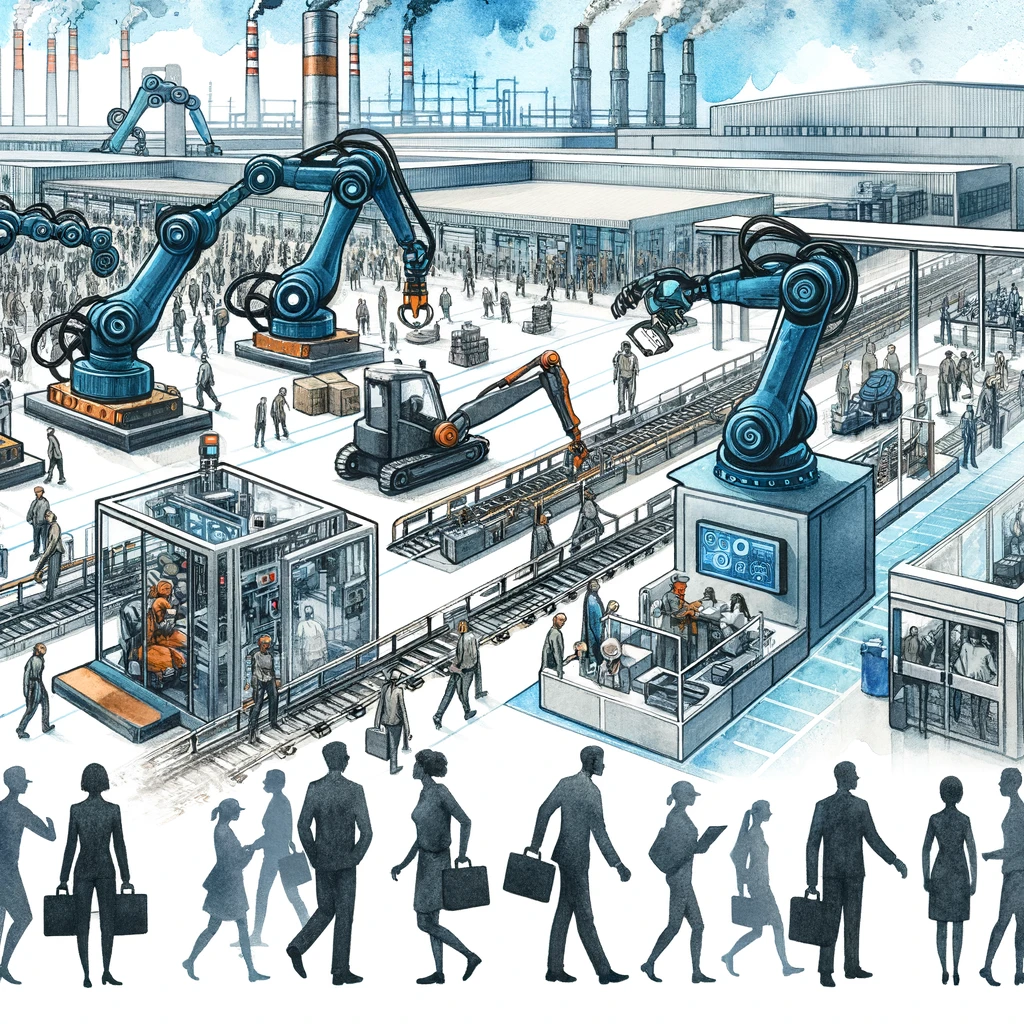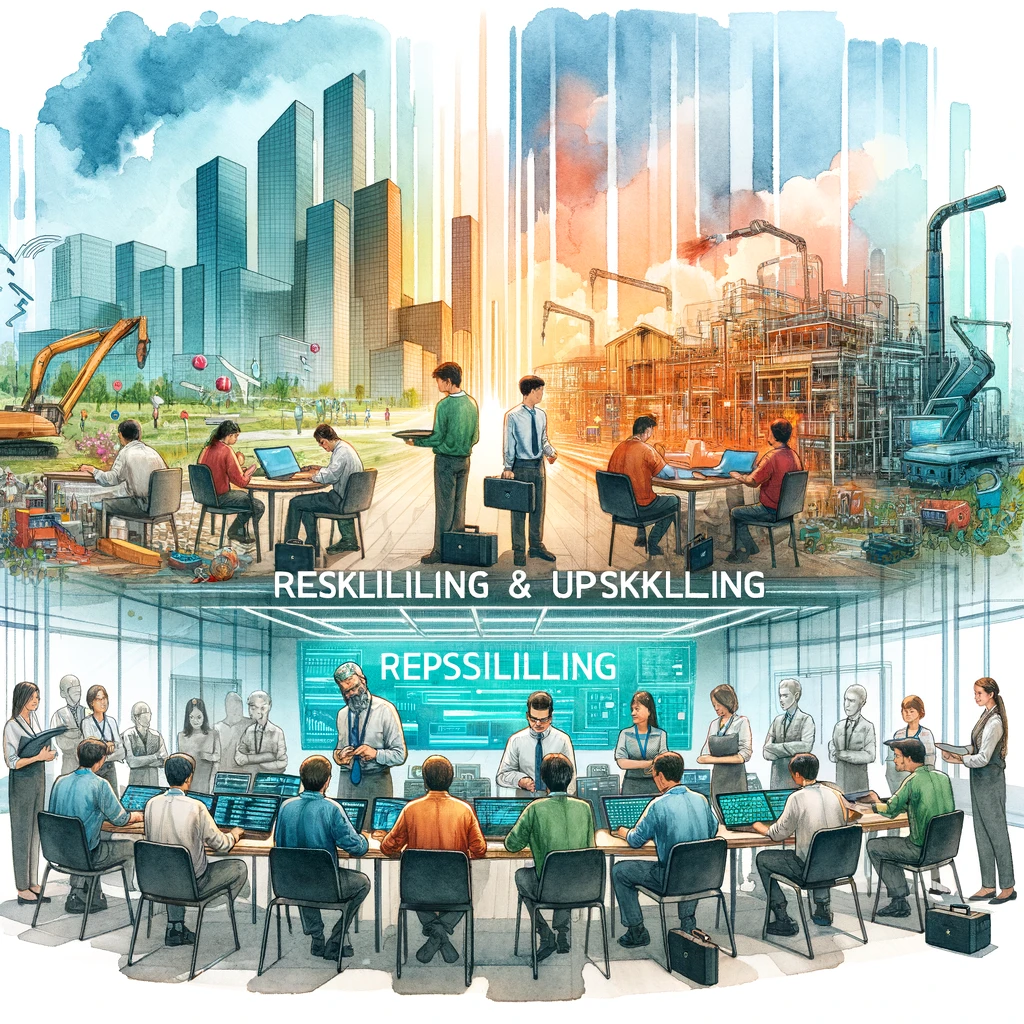Automation, driven by advances in technology such as artificial intelligence (AI), robotics, and machine learning, has significant implications for employment. While it offers opportunities for increased productivity and economic growth, it also poses challenges, particularly in terms of job displacement. This article explores the multifaceted impact of automation on employment, focusing on job displacement, the need for reskilling and upskilling, the creation of new job roles, broader economic impacts, and policy responses.

Job Displacement
1.1 Potential for Job Loss:
Automation is rapidly transforming industries by taking over tasks that were previously performed by humans. This shift can lead to significant job displacement, particularly in sectors that rely heavily on repetitive and manual labor.
Affected Industries:
- Manufacturing: Automation has a substantial impact on manufacturing, where robots and automated systems are used for tasks like assembly, welding, and packaging. According to the World Economic Forum, automation could displace around 20 million manufacturing jobs globally by 2030.
- Services: The services sector, including roles in customer service, data entry, and retail, is also vulnerable to automation. For example, chatbots and AI-powered customer service systems are increasingly replacing human agents.
- Logistics: Automated warehouses and robotic systems are transforming the logistics industry, reducing the need for human labor in tasks such as order picking and sorting.
Case Study:
- Amazon Warehouses: Amazon’s use of robots in its warehouses has significantly increased efficiency but has also led to a reduction in the need for human workers in some roles. While the company has created new jobs, the nature of these roles often requires different skills than traditional warehouse work.
Challenges:
- Skill Mismatch: Workers displaced by automation may lack the skills required for new roles created by technological advancements, leading to a mismatch in the labor market.
- Economic Inequality: Job displacement due to automation can exacerbate economic inequality, as lower-skilled workers are more likely to be affected and may find it harder to transition to new employment.

Reskilling and Upskilling
2.1 Importance of Workforce Adaptation:
To mitigate the impact of job displacement and prepare workers for the future job market, reskilling and upskilling are crucial. These processes involve acquiring new skills or upgrading existing ones to adapt to new technologies and job roles.
Key Areas for Reskilling:
- Digital Literacy: Workers need to develop digital skills to effectively use technology in various job roles, from basic computer skills to more advanced knowledge in areas like data analysis and programming.
- Technical Skills: Technical training in fields such as robotics, AI, and cybersecurity can prepare workers for new roles in the tech-driven economy.
- Soft Skills: Skills such as critical thinking, problem-solving, and adaptability are increasingly important in a rapidly changing job market.
Case Study:
- Siemens’ Reskilling Initiatives: Siemens, a global technology company, has implemented extensive reskilling programs for its workforce, focusing on digital skills and advanced manufacturing technologies. These initiatives aim to prepare employees for new roles created by automation and digitalization.
Challenges:
- Access to Training: Providing access to quality training programs is a challenge, particularly for workers in low-income or rural areas who may lack the resources to pursue reskilling opportunities.
- Lifelong Learning: The concept of lifelong learning is essential in an era of rapid technological change, requiring continuous efforts to update skills and knowledge throughout one’s career.
Creation of New Job Roles
3.1 New Opportunities in Technology:
While automation may lead to job displacement in some sectors, it also creates new job opportunities, particularly in fields related to technology and innovation.
Emerging Job Roles:
- Tech Development: There is a growing demand for professionals in software development, AI, data science, and robotics to design, implement, and maintain new technologies.
- Maintenance and Supervision: Automation creates the need for roles focused on maintaining and supervising automated systems, such as robotic technicians and system integrators.
- Data Analysis: The rise of big data analytics has created new job opportunities for data analysts and scientists who can interpret complex data and derive actionable insights.
Case Study:
- Google’s AI Research: Google’s investment in AI research has not only advanced the field but also created numerous job opportunities for AI researchers, engineers, and data scientists. This highlights the potential for automation to generate high-skilled employment in emerging sectors.
Challenges:
- Skill Gaps: The rapid pace of technological change can lead to skill gaps, where the demand for new roles outstrips the supply of qualified workers.
- Transition Support: Ensuring that displaced workers can transition into new job roles requires targeted support, including career counseling and job placement services.
Economic Impact
4.1 Broader Economic Implications:
The impact of automation extends beyond individual job roles to broader economic changes, influencing productivity, wage structures, and economic growth.
Key Impacts:
- Productivity Gains: Automation can significantly boost productivity by enabling faster and more efficient production processes. According to a McKinsey report, automation could raise productivity growth globally by 0.8 to 1.4% annually.
- Wage Disparities: Automation tends to increase demand for high-skilled workers, leading to wage growth in these sectors. However, it can also depress wages for low-skilled workers who face greater competition from automated systems.
- Economic Growth: By increasing efficiency and reducing costs, automation can contribute to overall economic growth. It can also spur innovation and the development of new products and services, further boosting economic activity.
Case Study:
- South Korea’s Automation Strategy: South Korea’s extensive investment in automation has led to significant productivity gains in manufacturing, helping the country maintain its competitive edge in global markets. This investment has also driven economic growth and job creation in high-tech industries.
Challenges:
- Income Inequality: The benefits of automation may not be evenly distributed, leading to increased income inequality between high-skilled and low-skilled workers.
- Economic Disruption: Rapid adoption of automation can lead to economic disruption, particularly in regions or industries heavily reliant on low-skilled labor.
Policy Responses
5.1 Government Initiatives to Mitigate Impact:
Governments play a critical role in addressing the challenges posed by automation through policies that support workforce transition and economic stability.
Key Policy Responses:
- Vocational Training Programs: Government-sponsored vocational training programs can help workers develop new skills needed for emerging job roles. For example, Germany’s dual education system combines vocational training with classroom learning, preparing workers for the modern labor market.
- Social Safety Nets: Strengthening social safety nets, such as unemployment benefits and job placement services, can provide a buffer for workers affected by job displacement and help them transition to new employment.
- Incentives for Lifelong Learning: Policies that encourage lifelong learning, such as tax incentives for education and training, can help workers continuously update their skills and remain competitive in the job market.
Case Study:
- Singapore’s SkillsFuture Program: Singapore’s SkillsFuture program offers subsidies and grants for citizens to pursue education and training throughout their careers. This initiative aims to build a resilient workforce that can adapt to technological changes and emerging job opportunities.
Challenges:
- Policy Implementation: Effective implementation of policies requires coordination between government, industry, and educational institutions to ensure that training programs meet the needs of the labor market.
- Balancing Innovation and Regulation: Policymakers must balance the need to promote innovation and technological advancement with the need to protect workers and ensure economic stability.
Conclusion
Automation has a profound impact on employment, presenting both challenges and opportunities. While it can lead to job displacement in certain sectors, it also creates new job roles and drives economic growth. To navigate these changes, it is crucial to invest in reskilling and upskilling workers, support workforce transitions, and implement policies that promote inclusive growth. For UPSC aspirants, understanding the dual impact of automation and the role of policy responses is essential for addressing the future challenges and opportunities in the Indian labor market.
Instructions for Writers:
Discuss the dual impact of automation on job displacement and job creation, providing examples of affected industries and analyzing policy responses to support workforce transitions. Include case studies and statistical data to illustrate your points, ensuring the content is detailed, informative, and relevant for UPSC exam preparation.


